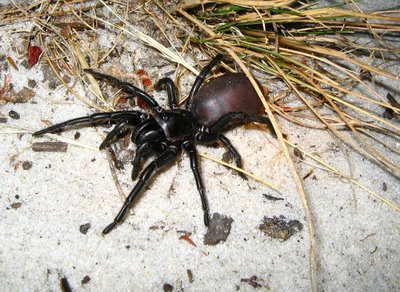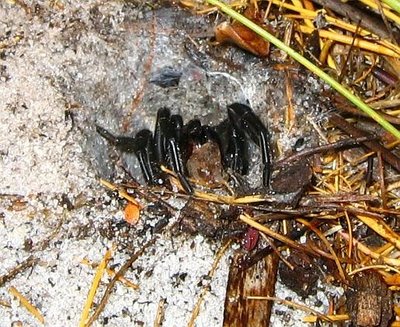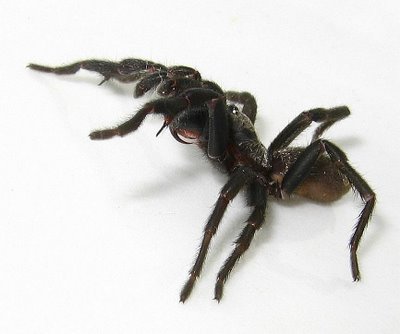Aname species a Black Wishbone Spider, also known as the False Funnel-web
These spiders belong to the suborder Mygalomorphae, which are medium to large primitive spiders, with downward pointing fangs requiring them to strike down on their prey. The female of the Black Wishbone Spider is quite large and to some can look very frightening, but fortunately she seldom leaves her burrow unless attacked by predators like scorpions and centipedes.

Aname species - Black Wishbone Spider
Her body length can exceed 3 cm and if disturbed is usually very aggressive.

They build a near vertical tunnel lined with silk, sometimes branched into a wishbone shape, but do not construct a trap door, leaving the entrance to the burrow open from which they spring upon any passing prey. Should you want a heart stopping experience, just pretend you are an insect outside their burrow and see how fast they can appear. The burrow entrance however, is often blocked during the hot summer months, probably to conserve moisture.

Below she is carrying/bulldozing sand from her burrow.

The site of recently excavated sand with the burrow entrance.
 The male of this species whilst looking for the ladies, can be found wandering around at night, particularly after rain in spring and autumn. Being smaller, he needs to protect himself from being regarded as prey from the much larger and heavier female, this he does by restraining her with strong spurs on the front legs that can be seen in the photo below.
The male of this species whilst looking for the ladies, can be found wandering around at night, particularly after rain in spring and autumn. Being smaller, he needs to protect himself from being regarded as prey from the much larger and heavier female, this he does by restraining her with strong spurs on the front legs that can be seen in the photo below. The male although smaller in body size, have very large fangs and should not be messed with. Although the venom from this species is not as toxic to humans (no known fatalities) as the Sydney Funnel-web, they can still inflict a very deep and painful bite.
The male although smaller in body size, have very large fangs and should not be messed with. Although the venom from this species is not as toxic to humans (no known fatalities) as the Sydney Funnel-web, they can still inflict a very deep and painful bite.
What a brilliant series of images!
ReplyDeleteA fearsome little critter, for sure, but a person can really appreciate the value and beauty of ALL nature around us when others have the enthusiasm to share their knowledge and interest.
Thank you for sharing the nature you encounter and observe.
Gaye
Congratulations on a brilliant series of photos and an informative text.
ReplyDeleteAs the resident of a bush block on the outskirts of Pemberton,we have to endure the rather scary wanderings of male wishbone spiders across our floor every year at around this time. They seem to be larger than 3cm in body length, even the males. I have become quite adept at capturing them under a clear plastic jar and then releasing them far from the house - as I did tonight. My nightmare is waking up in bed with one, although this hasn't happened over the past 17 years - hooray!
Keep up the good work, I will certainly be revisiting your, probably with a tale about an antechinus or two.
Hi Channycheese
ReplyDeleteYour place sounds like an Arachnophobes nightmare. :) I would love to see some Antechinus antics as I have not seen any for many years.
If the male mygalomorph has a body length greater than 3 cm, it may not be the Black Wishbone Spider, but one of the many others.
Shortly I shall be recording some of these burrowing spiders in one of my other blogs: http://esperancewildlife.blogspot.com/
So it might be worth checking out in about 3-4 weeks time.
Good to hear from you.